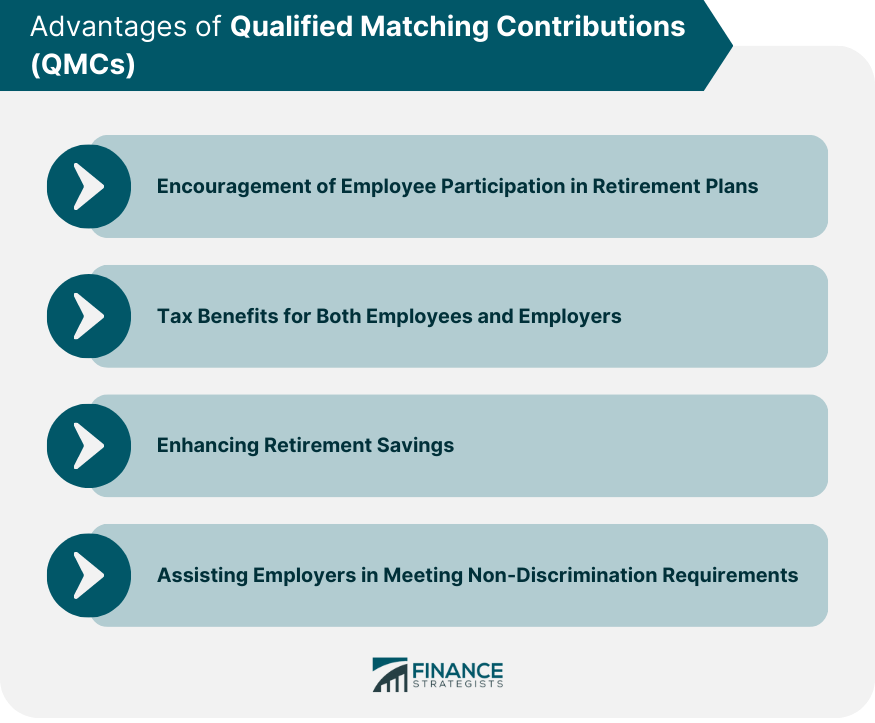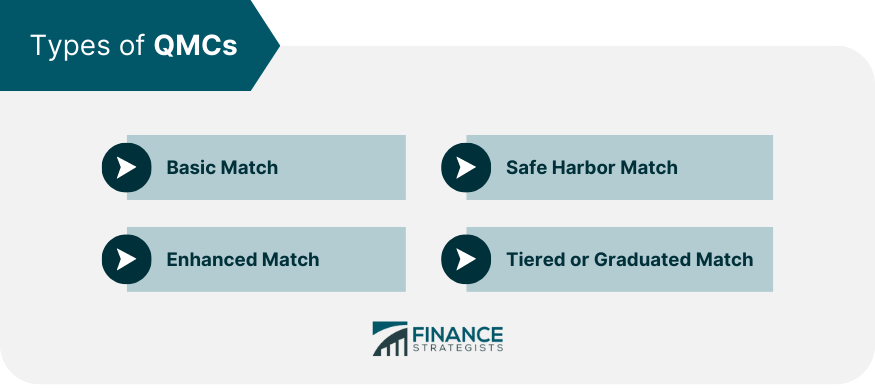Qualified Matching Contributions (QMCs) are employer contributions made to an employee's retirement plan account, designed to match a portion of the employee's own contributions. These contributions encourage employees to participate in their company-sponsored retirement plans and promote long-term savings for retirement. QMCs serve multiple purposes, including providing employees with an incentive to contribute to their retirement accounts, offering tax benefits to both employees and employers and helping employers meet non-discrimination requirements set by the Internal Revenue Service (IRS). QMCs are typically found in 401(k), 403(b), and 457(b) retirement plans. These plans allow employees to save for retirement on a tax-deferred basis, and QMCs provide additional employer support for these savings efforts. QMCs incentivize employees to contribute to their retirement accounts by providing a dollar-for-dollar match, or a percentage match, of the employee's contributions. This "free money" encourages employees to take advantage of the retirement plan benefits their employers offer. QMCs offer tax advantages to both employees and employers. Employees benefit from tax-deferred growth on their investments, while employers can claim a tax deduction for their matching contributions. By offering QMCs, employers can help employees accumulate more substantial retirement savings, providing their workers with a more secure financial future. QMCs can help employers meet the nondiscrimination requirements set by the IRS, ensuring that all employees receive retirement benefits equitably. QMCs are commonly offered in the following types of retirement plans: Employers who sponsor a retirement plan that includes QMCs must adhere to specific rules and regulations, including contribution limits and vesting requirements. Employees participating in a retirement plan offering QMCs must meet certain criteria, such as minimum service requirements or contribution levels. A basic match is a straightforward employer matching contribution, typically a fixed percentage of the employee's salary deferral. An enhanced match offers a higher percentage match for employees who contribute more to their retirement plan. A safe harbor match is a type of QMC that automatically satisfies certain IRS non-discrimination tests, reducing the need for additional compliance testing. A tiered or graduated match provides different matching percentages based on the employee's contribution level, encouraging higher employee contributions. The employer determines the QMC formula, which may vary between companies. Common formulas include a dollar-for-dollar match or a percentage match. The IRS sets annual contribution limits for QMCs, which are subject to annual adjustments for inflation. Vesting schedules determine when an employee gains ownership of the employer's QMCs. These schedules can be immediate or based on years of service. QMCs grow tax-deferred within the employee's retirement account, providing a tax advantage to the employee. Employers can claim a tax deduction for their QMCs, providing a tax benefit to the company as well. This encourages employers to offer QMCs as part of their retirement plan packages. Employers must report QMCs on their annual tax filings and provide relevant information to employees for their individual tax returns. The IRS requires that retirement plans do not disproportionately benefit highly compensated employees (HCEs) compared to non-highly compensated employees (NHCEs). QMCs help employers meet this requirement by incentivizing plan participation across all income levels. The Actual Deferral Percentage (ADP) test compares the average salary deferral percentages for HCEs and NHCEs. QMCs can help employers pass this test by encouraging broader plan participation among NHCEs. The Actual Contribution Percentage (ACP) test compares the average employer-matching contributions for HCEs and NHCEs. Offering QMCs can assist employers in passing this test by ensuring equitable distribution of employer contributions among all employees. QMCs can be an essential tool for employers to satisfy nondiscrimination testing requirements, ensuring that retirement plan benefits are equitably provided to all employees. Employers must regularly monitor and administer their QMC programs to ensure compliance with IRS regulations and to adjust for changes in contribution limits and other factors. Employers should communicate clearly and concisely regarding QMC programs, helping employees understand the benefits and encouraging participation. Discretionary matching contributions differ from QMCs in that employers can choose to make these contributions yearly rather than being committed to a set formula. Non-elective contributions are employer contributions made to all eligible employees, regardless of whether the employee contributes to the retirement plan. Profit-sharing contributions are based on a company's profits and are allocated to employees' retirement accounts according to a predetermined formula. These contributions are not directly tied to employee deferrals, unlike QMCs. Qualified Matching Contributions are a valuable tool for both employers and employees in retirement planning. By offering QMCs, employers can incentivize their employees to participate in retirement plans and provide a more secure financial future for their workers. QMCs also offer tax benefits for both employees and employers and help meet non-discrimination requirements set by the IRS. There are different types of QMCs, including basic, enhanced, safe harbor, and tiered, and employers must adhere to specific rules and regulations when implementing them. It is also crucial for employers to communicate clearly and educate their employees on the benefits of QMCs. QMCs differ from other types of matching contributions such as discretionary matching contributions, non-elective contributions, and profit-sharing contributions. Overall, QMCs are a valuable tool for employers to encourage employee participation in retirement plans and provide financial security for their workers.What Are Qualified Matching Contributions (QMCs)?
Advantages of QMCs
Encouragement of Employee Participation in Retirement Plans
Tax Benefits for Both Employees and Employers
Enhancing Retirement Savings
Assisting Employers in Meeting Non-Discrimination Requirements

QMC Eligibility and Requirements
Plans Offering QMCs
Employer Eligibility
Employee Eligibility
Types of QMCs
Basic Match
Enhanced Match
Safe Harbor Match
Tiered or Graduated Match

QMC Calculation and Limits
Matching Contribution Formula
Annual Contribution Limits
Vesting Schedules
Tax Implications of QMCs
Employee Taxation
Employer Taxation
Reporting Requirements
QMCs and Non-Discrimination Testing
Highly Compensated Employees (HCEs) and Non-Highly Compensated Employees (NHCEs)
Actual Deferral Percentage (ADP) Test
Actual Contribution Percentage (ACP) Test
QMCs as a Tool for Passing Non-Discrimination Tests
Implementing QMCs in a Retirement Plan
Steps for Employers to Establish QMCs
1. Determine the type of QMC to offer (basic, enhanced, safe harbor, or tiered).
2. Set the matching contribution formula and limits.
3. Establish a vesting schedule.
4. Communicate the QMC program to employees.
5. Monitor and administer the QMC program.Monitoring and Administration of QMCs
Communication and Education for Employees
QMCs in Comparison to Other Matching Contributions
Discretionary Matching Contributions
Non-Elective Contributions
Profit-Sharing Contributions
Conclusion
Qualified Matching Contributions (QMCs) FAQs
Qualified Matching Contributions (QMCs) are employer contributions made to an employee's retirement plan account, designed to match a portion of the employee's own contributions. QMCs encourage employees to participate in their company-sponsored retirement plans and promote long-term savings for retirement.
QMCs benefit employees by incentivizing them to contribute to their retirement accounts, offering tax-deferred investment growth, and enhancing their retirement savings. Employers benefit from QMCs by claiming a tax deduction for their contributions and meeting non-discrimination requirements set by the IRS.
QMCs are commonly offered in 401(k), 403(b), and 457(b) retirement plans. These plans allow employees to save for retirement on a tax-deferred basis, and QMCs provide additional employer support for these savings efforts.
QMCs are calculated based on a formula determined by the employer, which may include a dollar-for-dollar match or a percentage match of the employee's contributions. The IRS sets annual contribution limits for QMCs, which are subject to annual adjustments for inflation.
QMCs help employers meet non-discrimination requirements set by the IRS by encouraging retirement plan participants across all income levels. By offering QMCs, employers can satisfy nondiscrimination testing requirements, ensuring that retirement plan benefits are equitably provided to all employees.
True Tamplin is a published author, public speaker, CEO of UpDigital, and founder of Finance Strategists.
True is a Certified Educator in Personal Finance (CEPF®), author of The Handy Financial Ratios Guide, a member of the Society for Advancing Business Editing and Writing, contributes to his financial education site, Finance Strategists, and has spoken to various financial communities such as the CFA Institute, as well as university students like his Alma mater, Biola University, where he received a bachelor of science in business and data analytics.
To learn more about True, visit his personal website or view his author profiles on Amazon, Nasdaq and Forbes.











